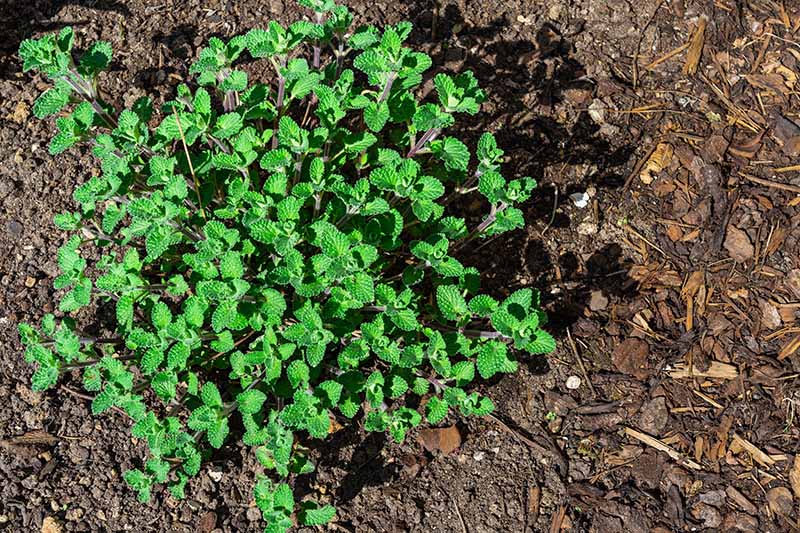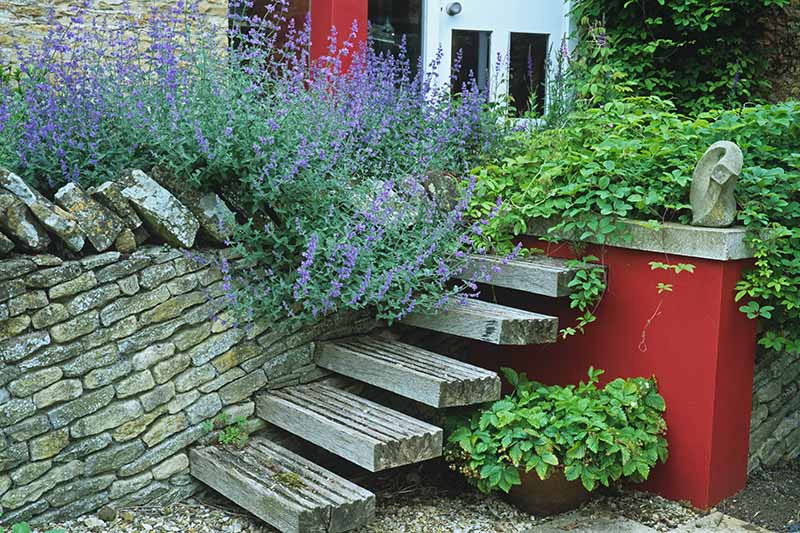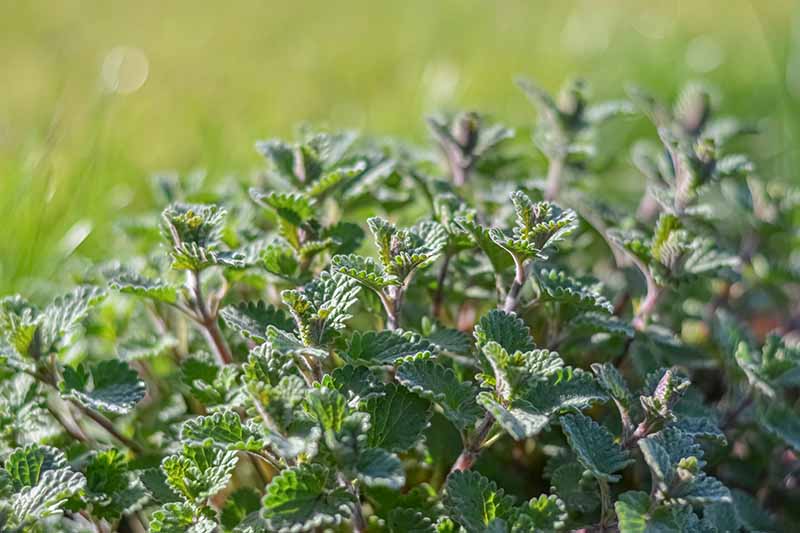Nepeta is a group of flowering perennials in the mint family. Catnip and Faassen’s catmint are both in this group.
We link to vendors to help you find relevant products. If you buy from one of our links, we may earn a commission.
Plus, these hardy perennials are very easy to grow because you don’t have to worry about many pests or other problems.
There are 250 species of herbaceous perennials and a few annuals in the genus Nepeta. About 20 of these species and cultivars are currently grown in gardens.
For the most part, they grow wild in dry, sunny places with dry, rocky soils in USDA Hardiness Zones 3 through 9.
Several commonly grown species are in this genus. Most of them have square stems, heart-shaped to gray-green leaves that are opposite each other, and small tubular flowers that bloom in shades of lavender, white, pink, or blue from spring to fall.
Some popular ones include catnip (Nepeta cataria), Persian catmint (N. mussinii), and Faassen’s catmint (N x faassenii).
Though to make matters confusing, the common names “catnip” and “catmint” are used to refer to multiple species.
N. Cataria, also called catnip, catwort, or catmint, is a traditional medicine herb that we use to make our cats crazy. Other plants in the same genus may also be appealing to cats.
N. racemosa (aka N. mussinii) is also referred to as catmint, dwarf catnip, or raceme catnip.
This plant grows slowly and has lilac-colored flowers. It is often used as a border or ground cover in flower beds.
N. x faassenii, an N. racemosa hybrid also known as Faassen’s catmint, is a compact mounding hybrid with small but attractive lavender flowers. It is also grown primarily for its ornamental value.
This genus has species that come from Europe, Asia, and Africa. Many of them have become naturalized in North America and other places around the world. N. Folks who came to North America in the 1800s brought cataria with them and used it as a cooking herb.
In many cultures, these plants have been used as medicine for a long time. Children with colic, stress, fevers, or stomachaches are often given this tea.
Catnip tea is often sold by herbal companies these days. They advertise it as a digestive aid that calms, among other things.
There is also an oil in plants called nepetalactone that makes cats temporarily go crazy because it affects their nervous system.
Nepeta plants grow and spread easily, and are very easy to propagate in a number of different ways.
You can start seeds indoors four to eight weeks before the last frost. Fill three- or four-inch pots with potting mix and press seeds into the soil, barely covering.
For two to three weeks, until seedlings appear, keep the soil moist. Then, put the pots in bright light until they get at least two sets of true leaves.
You can also plant seeds directly outside before the first frost in the fall or after the last frost in the spring.
Putting seeds in the freezer overnight and then soaking them in water for 12 to 24 hours before planting can help them sprout.
Prepare a garden bed or container with garden soil mixed with an inch of organic matter. Sprinkle seeds on top, barely covering since light aids germination for these plants.
Water lightly and keep moist until sprouts appear, in two to three weeks. Thin seedlings to about 18 inches apart.
It is important to note that not all nepeta species can be started from seed. Some, such as Faassen’s catmint, are sterile and can only be propagated by division or from cuttings. Fortunately, this is easy to do.
If you have already established plants, dividing them is probably the easiest and fastest way to make more plants. You can divide plants at any time during the growing season, but it’s best to wait until the cooler months to do it.
Find a part of a well-established plant with strong, mature roots. Use a garden spade to cut it off from the rest of the plant vertically, then carefully dig it up.
It’s also possible to dig up the whole plant, cut it up, and then plant each piece directly in the garden or in a pot.
If you cut off the top three to four inches of a stem just below a leaf node when new growth starts to show up in the spring, Remove the lower leaves from the cutting, leaving the top two to four intact.
To get cuttings to grow roots in soil, put the cut end into a 4-inch pot filled with potting mix and place it somewhere warm that gets indirect or filtered light. Water regularly until new growth appears.
This should happen within a few weeks, and serves as a good sign that the cutting has rooted. After this, it can be moved to its permanent spot in the garden or repotted in a bigger pot.
Cut pieces can also be put in a glass with a few inches of cool water and left in indirect light.
The water should be deep enough to cover at least a few leaf nodes, but not so deep that any whole leaves are submerged. Refresh the water every couple of days and roots should appear in a week or less.
At this point you can transplant them into a four-inch pot filled with sterile potting mix. Water regularly and provide filtered light until new growth appears, then replant as described above.
You can harden off seedlings before planting them in the garden by moving them to a protected spot outside for a short time.
After the risk of frost has passed, plant in the garden 18 inches apart in holes dug deep enough to reach the roots.
Catmint (Nepeta) is an easy-to-grow perennial herb with fragrant foliage and beautiful blooms that attract pollinators. Growing catmint from seed is a great option for any gardener looking to add this useful and ornamental plant to their landscape. In this complete guide, I’ll share tips on when where and how to plant catmint seeds both indoors and outdoors.
An Overview of Catmint
Before diving into the specifics of growing catmint from seed let’s first take a look at some background on this lovely plant
-
Botanical name Nepeta species including N. mussinii, N. faassenii and others. Sometimes called catnip.
-
Plant type: Herbaceous perennial in the mint family Lamiaceae.
-
Hardiness: Zones 3-8.
-
Exposure: Full sun to partial shade.
-
Soil: Average to dry; well-draining. Prefers slightly alkaline soil.
-
Height and spread: Typically 1-3 feet tall and wide.
-
Features: Gray-green aromatic foliage and spikes of blue, pink, or white flowers attractive to bees and butterflies. Drought tolerant once established. Deer resistant.
-
Uses: Ornamental borders, pollinator gardens, edging paths, cat toys/treats, herbal tea, medicinal uses.
When to Start Catmint Seeds
Catmint can be started indoors or directly sown outside. Here are some tips on timing for both methods:
-
Indoors: For transplanting into the garden later, start seeds indoors 6-8 weeks before your last expected spring frost date.
-
Outdoors: Direct sow outdoors in spring once danger of frost has passed. Seeds need soil temperatures of at least 65°F to germinate.
-
In warm climates, catmint can be fall sown for winter flowering.
Where to Plant Catmint
When preparing your garden bed or containers for catmint, consider the following:
-
Sun: Catmint thrives in full sun to light afternoon shade. Provide at least 6 hours of direct sun daily.
-
Soil: Prefers average to dry, well-draining soil. Amend heavy clay soils with compost.
-
Drainage: Avoid wet, poorly draining sites which can lead to root rot. Improve drainage if needed.
-
pH: Grows best in neutral to slightly alkaline soil, around pH 6.6-7.5.
-
Spacing: Space catmint plants 12-24 inches apart depending on variety size.
How to Plant Catmint Seeds
Catmint seeds are very small, so proper planting technique is important for good germination. Follow these tips when sowing catmint seeds either indoors or out:
-
Indoors: Fill sterile seed starting mix in containers and lightly press down. Scatter seeds across the surface and press in gently. Cover very lightly with more mix or vermiculite.
-
Outdoors: Prepare soil and rake smooth. Scatter seeds and press lightly into soil surface. Cover seeds with 1/8 inch fine soil or compost.
-
Depth: Do not bury catmint seeds; they require light to germinate. Surface sow or cover very lightly.
-
Spacing: Sow seeds 2-3 inches apart to allow room for thinning later on.
-
Keep moist: Maintain even moisture on surface; avoid letting seed beds dry out.
Caring for Catmint
With proper care, catmint is relatively easy to grow. Here are some tips for looking after catmint plants:
-
Water new seedlings regularly to keep soil consistently moist but not soaked. Mature plants are quite drought tolerant.
-
Thin seedlings or transplant to final spacing of 12-24 inches apart depending on variety size.
-
Apply organic mulch around plants to help retain moisture and control weeds.
-
Cut back flowers after first bloom to encourage repeat flowering. Deadhead spent blooms to neaten appearance.
-
Avoid fertilizing catmint, as it can lead to fast, weak growth prone to mildew.
-
Clip off faded foliage in late fall to tidy plants before winter if desired. Cut back hard in spring to rejuvenate growth.
-
Deer and rabbits generally don’t bother catmint due to its fragrance, but chicken wire cages may be needed.
Harvesting Catmint
-
Harvest leaves anytime once plant is established. Cut individual stems or shear back growth.
-
For flowers, cut stems when blooms are open. Air dry upside down in bunches.
-
Catmint spreads via both seed and underground rhizomes. Divide congested plants in spring or fall to propagate.
Nepeta x faassenii ‘Walker’s Low’
This popular N. The x faassenii cultivar has tall spikes of trumpet-shaped lavender blue flowers that bloom all summer and into fall. It also has dusty gray-green fragrant leaves.
This hardy perennial plant grows to be two to three feet tall and is great for cascading over a wall or rocks. It doesn’t spread out as much as some other nepeta types.
Seeds of this cultivar are sterile, but you can buy one- to two-year-old plants from Nature Hills Nursery.
How to Grow Catmint Plants
Most species can tolerate a range of soil types, including sandy and rocky soils. Just be sure the soil is well draining with a pH between 5. 0 and 7. 5.
Find a location in full sun and work about an inch of compost into the soil. While this isn’t absolutely required, plants do tend to be bushier in soil that is more fertile.

If planting multiples, space about 18 inches apart.
It is also worth noting that some Nepeta species can spread aggressively. You can avoid this by planting in containers or raised beds.
Give it a lot of water when you plant it, and keep giving it about an inch of water a week for the first season. Established plants are drought tolerant and will only need water occasionally, if it hasn’t rained for several weeks.

Be sure to avoid overwatering. These plants do not tolerate wet feet!
Every season, putting a couple of inches of shredded bark, leaves, or straw mulch around the base of plants is a good way to keep the soil moist and help it drain better.
Mulch also helps regulate soil temperature and suppresses weeds.
- Plant in well draining soil with a pH between 5. 0 and 7. 5.
- Amend soil with an inch of compost to increase vigor.
- Space plants 18 inches apart.
- Provide an inch of water per week the first season. Established plants are drought tolerant.
- Put mulch around the base to help water drain and keep the soil at the right temperature.
Nepeta plants begin blooming in early summer and many species flower repeatedly throughout the season.
For a fuller second bloom, you can cut back or remove the flower heads to keep plants from getting floppy.

Trim foliage back significantly after flowering, removing about a third of the leaves.
Following the steps above to divide plants every season will help keep them in check if they are spreading too much. You can replant divided sections or give them to a friend.
How to grow Catmint/Nepeta, the best way to care for #catmint #nepeta
How do you grow a catmint plant?
To grow a catmint plant, choose a full sun location with well-draining soil. A lean soil and somewhat dry growing conditions will encourage both more flowers and a stronger scent. If you want to increase the number of catmint plants, the lack of viable seeds means you will need to either buy more plants or propagate new plants from divisions or cuttings.
What kind of soil does a catmint plant need?
Catmint plants can tolerate a range of soil types, including sandy and rocky soils. The soil should be well draining with a pH between 5.0 and 7.5. Find a location in full sun and work about an inch of compost into the soil. While this isn’t absolutely required, plants tend to be bushier in soil that is more fertile.
How do you grow catmint (Nepeta) from seeds?
To grow catmint (Nepeta) from seeds, prepare a garden bed or container with garden soil mixed with an inch of organic matter. Sprinkle seeds on top and barely cover them, as light aids germination for these plants. Water lightly and keep moist until sprouts appear, in about two to three weeks. Thin seedlings to about 18 inches apart.
What is a catmint plant?
Catmint is a low-maintenance plant that features lavender-blue flowers and belongs to the Lamiaceae family. Here’s how to plant, grow, and care for Nepeta (catmint) easily.
- The Ultimate Guide to Growing Strawberries in Raised Beds - August 8, 2025
- No-Dig Garden Beds: The Easiest Way to Grow a Beautiful Garden - August 6, 2025
- How to Protect and Preserve Wood for Raised Garden Beds - August 6, 2025

